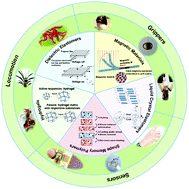Stimuli-responsive functional materials for soft robotics
Abstract
Functional materials have spurred the advancement of soft robotics with the potential to perform safe interactions and adaptative functions in unstructured environments. The responses of functional materials under external stimuli lend themselves to programmable actuation and sensing, opening up new possibilities of robot design with built-in mechanical intelligence and unlocking new applications. Here, we review the development of stimuli-responsive functional materials particularly used for soft robotic systems. This review covers five representative types of soft stimuli-responsive functional materials, namely (i) dielectric elastomers, (ii) hydrogels, (iii) shape memory polymers, (iv) liquid crystal elastomers, and (v) magnetic materials, with focuses on their inherent material properties, working mechanisms, and design strategies for actuation and sensing. We also highlight the state-of-the-art applications of soft stimuli-responsive functional materials in locomotion robots, grippers and sensors. Finally, we summarize the current challenges and map out future trends for engineering next-generation functional materials for soft robotics.

- This article is part of the themed collection: Journal of Materials Chemistry B Lunar New Year collection 2021


 Please wait while we load your content...
Please wait while we load your content...